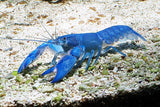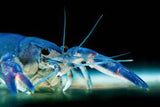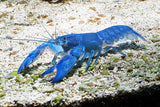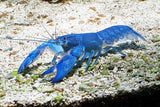This product is available instore only
Enquire below for further information
Common Name: Blue Pearl Yabbie
Scientific Name: Cherax Albidus
Size: Can grow to 20cm or more
Distribution: Cherax destructor is the most widely distributed Cherax species in Australia, and ranges through parts of South Australia, Victoria, New South Wales, Queensland and even the Northern Territory.
Temperature: From 8°C-25°C. Best at 12°C – 20°C.
PH: between 7.0 – 8.0.
Hardness: 50-300ppm.
Lifespan: 5 – 7 Years
Food: We sell sinking yabby pellets.
Colour: Usually brown/green on the shell with patterns on the claws. Yabbies also occur in very pale shades as well as blue forms.
Yabbies make an interesting addition to the home aquarium. They are quite comfortable in tropical or coldwater and can be kept with fish, (providing the fish are active and healthy). Yabbies are capable of eating aquatic plants and are therefore not recommended for display or plant tanks.
In a shop situation the use of rocks or short pieces of PVC pipe is recommended, as yabbies can become quite territorial if over crowded. For this reason it is not recommended that more than one yabby be housed in small aquariums or bowls. If your customers want to keep more than one, large aquariums with plenty of hiding places are required.
Yabbies breathe through gills, which are situated along each side of the body. For this reason good aeration and filtration are important for their wellbeing.
As yabbies grow they regularly shed their outer skeleton (moult) and at this time may be attacked and eaten by large fish eg. fully grown Oscars. They are quite safe in with average community tank species. If for any reason yabbies lose claws or limbs these will be re-grown over the next few moults.
Yabbies, as with other invertebrates, are sensitive to copper in water, therefore do not use aquarium medications containing copper in their tank.
If plants or decorations reach near the top of the aquarium, a coverglass should be used as yabbies may escape under these circumstances.
Yabbies will breed when the temperature is above 15°C and the day length exceeds 14 hours. Up to three hundred eggs are stuck under the mother’s tail, where they hatch from a few weeks up to several months depending on temperature. Baby yabbies should be separated from the adults and be fed baby fish food (that sinks).
Blue pearl yabbies are the result of selective breeding and some colour variations have been quite spectacular. The name C. albidus is arguable in some groups as being thought of as just a variation of C.destructor. Cherax albidus tends to be more slender and has a mat of dense setae on claws. The housing should be treated exactly like C. destructor.
They are hardy and quite comfortable in cold or tropical water. They will dig and eat plants so not recommended for display or plant tanks. They can also be territorial so provide plenty of hides. As yabbies grow they shed their shell and at this time can be vulnerable and eaten by other tank inhabitants. If for any reason yabbies lose a limb, these will be regrown over the next few moults. As with other invertebrates, they are sensitive to copper treatments.
Scientific Name: Cherax Albidus
Size: Can grow to 20cm or more
Distribution: Cherax destructor is the most widely distributed Cherax species in Australia, and ranges through parts of South Australia, Victoria, New South Wales, Queensland and even the Northern Territory.
Temperature: From 8°C-25°C. Best at 12°C – 20°C.
PH: between 7.0 – 8.0.
Hardness: 50-300ppm.
Lifespan: 5 – 7 Years
Food: We sell sinking yabby pellets.
Colour: Usually brown/green on the shell with patterns on the claws. Yabbies also occur in very pale shades as well as blue forms.
Yabbies make an interesting addition to the home aquarium. They are quite comfortable in tropical or coldwater and can be kept with fish, (providing the fish are active and healthy). Yabbies are capable of eating aquatic plants and are therefore not recommended for display or plant tanks.
In a shop situation the use of rocks or short pieces of PVC pipe is recommended, as yabbies can become quite territorial if over crowded. For this reason it is not recommended that more than one yabby be housed in small aquariums or bowls. If your customers want to keep more than one, large aquariums with plenty of hiding places are required.
Yabbies breathe through gills, which are situated along each side of the body. For this reason good aeration and filtration are important for their wellbeing.
As yabbies grow they regularly shed their outer skeleton (moult) and at this time may be attacked and eaten by large fish eg. fully grown Oscars. They are quite safe in with average community tank species. If for any reason yabbies lose claws or limbs these will be re-grown over the next few moults.
Yabbies, as with other invertebrates, are sensitive to copper in water, therefore do not use aquarium medications containing copper in their tank.
If plants or decorations reach near the top of the aquarium, a coverglass should be used as yabbies may escape under these circumstances.
Yabbies will breed when the temperature is above 15°C and the day length exceeds 14 hours. Up to three hundred eggs are stuck under the mother’s tail, where they hatch from a few weeks up to several months depending on temperature. Baby yabbies should be separated from the adults and be fed baby fish food (that sinks).
Blue pearl yabbies are the result of selective breeding and some colour variations have been quite spectacular. The name C. albidus is arguable in some groups as being thought of as just a variation of C.destructor. Cherax albidus tends to be more slender and has a mat of dense setae on claws. The housing should be treated exactly like C. destructor.
They are hardy and quite comfortable in cold or tropical water. They will dig and eat plants so not recommended for display or plant tanks. They can also be territorial so provide plenty of hides. As yabbies grow they shed their shell and at this time can be vulnerable and eaten by other tank inhabitants. If for any reason yabbies lose a limb, these will be regrown over the next few moults. As with other invertebrates, they are sensitive to copper treatments.








